As I was leaving for the hospital, I grabbed a book from the bookshelf near the bedroom door. I chose it because it was a small paperback I could slip into my little bag of belongings.
Just as well. There were delays and lots of time to read. By the time I was wheeled into the operating room, I was already enthralled with My Convent Life by George Sand. It is a translated extract from her voluminous autobiography, Histoire de ma Vie, published in 1855. The events in the book take place between 1817 and 1820, when Aurore Dupin, as she was known then, was at boarding school.
This portrait of her by George Sully dates from 1826.
The informative opening sentence drew me in right away.
The English Augustinian Convent Rue des Fossés St. Victor is one of the three or four British communities established in Paris in the time of Cromwell, and the only one left unharmed by the French Revolution.
(I do like descriptions that provide precise locations.) I found an image of the cloister – the proportions are probably exaggerated – painted in the 18th century by Hubert Robert. The convent’s official name was Notre-Dame-de-Sion.
Interesting that Aurore went to an English convent. Even more interesting in light of the fact that her paternal grandmother, Madame Dupin, had been incarcerated in that very building during the Revolution, when it was being used as a house of detention for women. Here is a picture of Madame Dupin, painted before the Revolution, fashionablly dressed in the style popularized by Marie-Antoinette. Don’t let the milkmaid outfit fool you. She was tough as nails.
Another inmate during the Revolution was the woman who was to become Aurore’s mother, Sophie-Victoire Delaborde, imprisoned for singing royalist songs. Sophie-Victoire was an orphan and the grand-daughter of a bird seller. And no, that is not how Sophie-Victoire got to know Madame Dupin’s son Maurice. They met much later and married in 1804, a month before Aurore’s birth in Paris.
The aristocratic Madame Dupin was appalled by the marriage of her son, a handsome hussar, to the grand-daughter of a bird seller. Maurice and Sophie-Victoire went on to have a second child, a son who died in 1808. A week after his son’s death, Maurice himself died after a fall from his horse. His death left the widowed Madame Dupin, Sophie-Victoire, and Aurore on their own. I can imagine the two older women glaring at each other over the girl’s head.
It was an unequal struggle. In 1810, Sophie-Victoire gave custody of her child to Madame Dupin in return for a pension, and moved out of the family house in Nohant in the Loire Valley (although she kept in touch with her daughter).
Boarding school may have come as something of a relief to Aurore, after life with Grandmother Dupin. She was there for the better part of three years. Her grandmother did not even let her come home for extended vacations, although she received occasional visits from family members.
The nuns at the convent presumably still wore the distinctive English Augustinian habit shown here, in an 18th-century painting. (I could find nothing much later than this, but nuns’ habits didn’t change much over the years in those days.) A thin black veil over a white coif, a heavier black mantle over a full and pleated white garment coming down past the knees, wide cream-coloured sleeves, and a plainer skirt underneath.
Most of the teaching, however, was relegated to laywomen of varying talents and dispositions. Sand provides little information about the curriculum, if there was one, although she mentions in passing music, English, and Italian. An early conflict in the story is between Aurore and Miss D–––, one of the lay teachers. Sand describes her as “harsh and often cruel, sly and vindictive, ill-tempered and ill-mannered,” yet Sand tries to be fair-minded – “I must say that she seemed really devout and austere – a sort of intolerant, detestable fanatic, who might have had a certain grandeur about her if she had lived long ago in the desert with the anchorites whose faith she emulated.” Eventually, the two are somewhat reconciled.
The school was officially divided into two groups by age and 13-year-old Aurore was placed in the lower division with the younger children. Her education to that point had been patchy, and she spoke no English. But the most meaningful distinctions in the school were made by the girls themselves: good girls (les sages), stupid girls (les bêtes), and devils (les diables). Aurore was immediately drawn to the last group, girls who delighted in doing whatever was forbidden.
Their mischief consisted largely of exploring out-of-bounds areas of the convent, an establishment that Sand describes as “mysterious and labyrinthine – in all its ugliness not devoid of a certain poetic charm.”
This drawing shows some of the buildings from the garden side, as well as two interior views.

It was really a collection of buildings, a main building and
several other constructions, very ruinous, a perfect maze of dark passages, spiral staircases, little detached buildings, connected with one another by flights of worn and uneven steps, or by boards thrown across… There were galleries that led nowhere and passages that you could hardly squeeze through to strange edifices… This part of the convent baffles description, and the uses to which these buildings were put were as various as their grouping.
For anyone who grew up either on the stories of Enid Blyton or those about Nancy Drew (or both), the appeal is immediate. Sign me up as a would-be diable!
Les diables penetrated the gloomy cellars, opened doors to disused rooms, and in one memorable episode, found themselves trapped on the roof. From her perch up there Aurore feels a shoe fall off, but later recovers it, unnoticed, in the garden.
The garden was vast, shaded by superb horse-chestnut trees. On one side a high wall separated us from the Scotch convent, and on the other stood a long row of small houses tenanted by pious ladies retired from the world. Besides this garden, there was also in front of the new building, a double quadrangle planted with vegetables, also bordered by houses, all occupied by old matrons or by boarding-pupils who had quarters to themselves.
I finished the book as I was recovering at home (doing nicely, thank you), and then went in search of the building. First, I had to find the Fossés St-Victor. A modern map of Paris did not include it, although there are three other streets named Fossés – St-Bernard, St-Jacques, and St-Marcel, all in the fifth arrondissement. Eventually, I found the street on Turgot’s map. It was part of what is now the rue Cardinal Lemoine. You’ll see it at the bottom of this image. You can see the gardens, the high wall separating the Augustinians from the Scotch congregation on the right, and the little houses on the left.

Gallica even provides a plan of the jumble of buildings composing the convent. The rue des Fossés St-Victor is on the right.
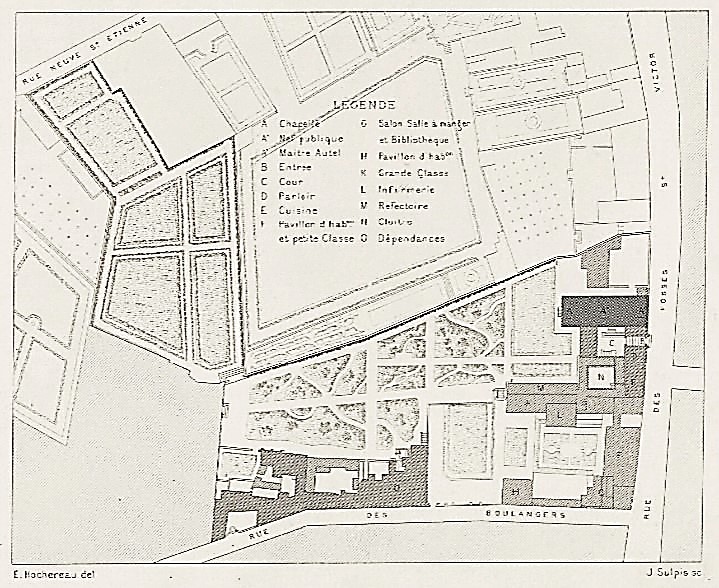
The convent moved to a new building in Neuilly* when its land was appropriated and the rue Monge created in the 1860s. The buildings that took its place date mostly from the late 19th and early 20th centuries. But in the process of carving up the block to create the new street, something else emerged from underneath those vast gardens: the Arènes de Lutèce.

Imagine if the diables had discovered that during their nocturnal explorations!
George Sand, in a drawing by Alfred de Musset, 1833.
Text by Philippa Campsie, Turgot map and convent plan from Gallica; drawing of convent from Musées de Paris; postcard of Arènes de Lutèce from http://photos.piganl.net/2017/lutece/lutece.php; all other images from Wikimedia Commons.
George Sand, My Convent Life, translated by Maria Ellery McKay (Chicago: Cassandra Press, 1978).
* After the 1901 law that put restrictions on religious orders, the nuns gradually dispersed and the Neuilly building was sold in 1913. The former convent is now home to the Lycée Sainte-Marie on the rue Victor-Hugo, Neuilly.

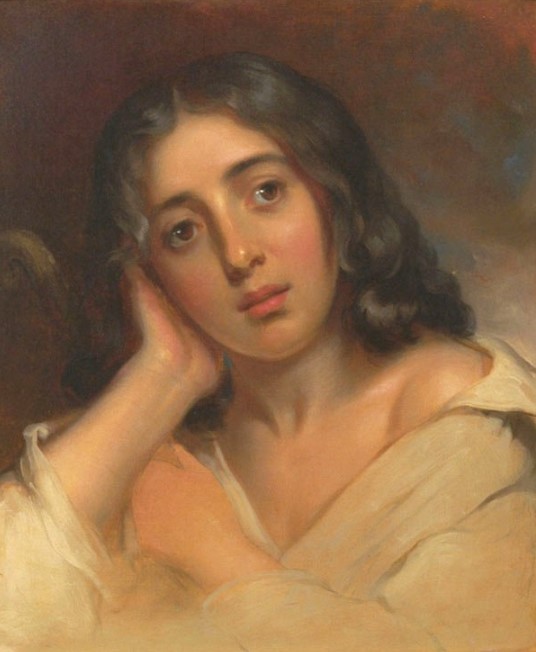



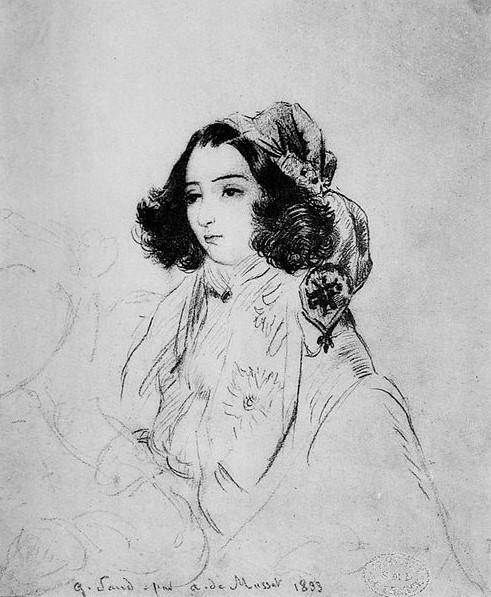





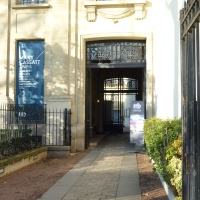

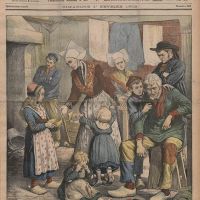












You are just the best historical sleuth! This was fascinating, from beginning to end. I laughed out loud at “Don’t let the milkmaid outfit fool you.” Hope you will be back on your feet soon.
Thank you very much. I am getting better every day. So glad you enjoyed the post.
Absolutely fascinating! I keep meaning to arrange a ‘girls’ outing to the house in Nohant, but just haven’t made the time to do it. It’s about an hour and a half drive from where I live. Several of my female French friends can quote whole paragraphs of George Sand, after having done her at school. And I wouldn’t mind a peek at the chateau where she discovered La Dame et la licorne tapestries.
I have ordered some of Sand’s books from the library. I feel I should know her work better than I do. Nohant sounds like a splendid outing. There is also quite a bit of Sand memorabilia at the Musee de la Vie Romantique.
What a fabulous little piece of history-so many layers and a perfect portrait of George Sand, so beautifully documented! I was just in Paris seeing a world of museums (from MAM, to the Musée Bourdelle,the Hotel Biron and the Invalides at midnight! Nuit des Musées) I must return to see les arenes de Lutece!
You can also find out more about George Sand at the Musee de la Vie Romantique. Go on a sunny day and have lunch in the garden.
This post made me think too of the Musée, which has plaster casts of Sand’s and Chopin’s arms. Sand’s is very delicate and very moving.
We did exactly that last week. Lovely cafe. Nice uncrowded museum
I enjoyed reading this. I translated a novel by George Sand, “Spiridion”, about a haunted monastery. I’ve read that some of the descriptive spooky elements were probably based on her memory of the convent she attended. I know you can read it in French (though it’s hard to find) but if you’re interested in the English edition, it was published by SUNY Press in 2015.
I have ordered a copy from the library and look forward to reading it. Thank you very much for letting me know about it. Have you translated other works by George Sand?
No, nothing else by George Sand, but many stories by 19th-century French authors, many set in Paris, and many freely available online. I went to Mallorca after the Spiridion translation came out, to see the monastery where she was writing part of it while living with Chopin. That’s an amazing place. Highly recommended.
Dear Trish,
I have just finished reading your amazing translation of Spiridion. An extraordinary piece of writing and an extraordinary work of translation. The intensity of the writing is such that I feel rather overwhelmed. I need to reread some parts to fully take it all in. Thank you for letting me know about it.
Philippa
Wow, thank you for reading it. It’s interesting in many ways, not least because it includes no women except for the author.
Glad you are having a good recovery!
Thank you so much. It has been quite a journey.
An enjoyable read. Thank You. It is a lovely spring day here in northern Ontario. The bugs are not out in full force as yet but I am sure that will come. Hate black flies!!! The spring means that my work on the Web pages of Famous Canadian Women slows down. On the bright side I now have over 4300 mini biographies posted. I hope that you and Norman are having an enjoyable spring as well. Please say ‘hello’ to him for me. I am hoping to be around in 2026 when the new Ottawa Archives and new Library and Archives building opens up. It is to be located in Lebreton Flats. Thank you again for sharing your Parisian Fields with me.
Dawn Monroe
Glad to hear things are well with you and your wonderful project. It is also a lovely day here, and we’ve been to the garden centre to get some things to brighten up the garden. I still can’t do much after my surgery, but we have a gardener who helps us occasionally and he will do the heavy lifting. Have a good summer.
Philippa, This is wonderful! I hope you are feeling better now…..sorry to hear you were in the hospital. Jane
Dear Jane, Thank you so much. I am definitely on the mend. Hope to see you soon. Wasn’t there an event at the Libby Gallery recently? How did that go? Philippa
Hi Philippa, Good to hear from you. I am glad you are feeling better. Yes, there was an “event” at Libby’s gallery recently. It was a very interesting watercolour show, with historical and contemporary work. They are still not getting a large crowd, since covid, but they are trying to get things back to normal. In the Fall they will be having a show celebrating their 45th year as an art gallery! I hope you and Norman can come to that. See you soon on Queen St., maybe? Take care, Jane
Dear Philippa,
Wonderful to learn that you are doing well, being on the mend, after this big operation! Sorry not to have been in touch. It has been quite a term.
Thank you for this great “promenade”. Did George Sand take the English form of the name George — in French, it is Georges with an s — because of her stay in this English monastery, I wonder?
See you soon, I hope,
Isabelle.
Pingback: Funeral march for a dead parrot | Parisian Fields